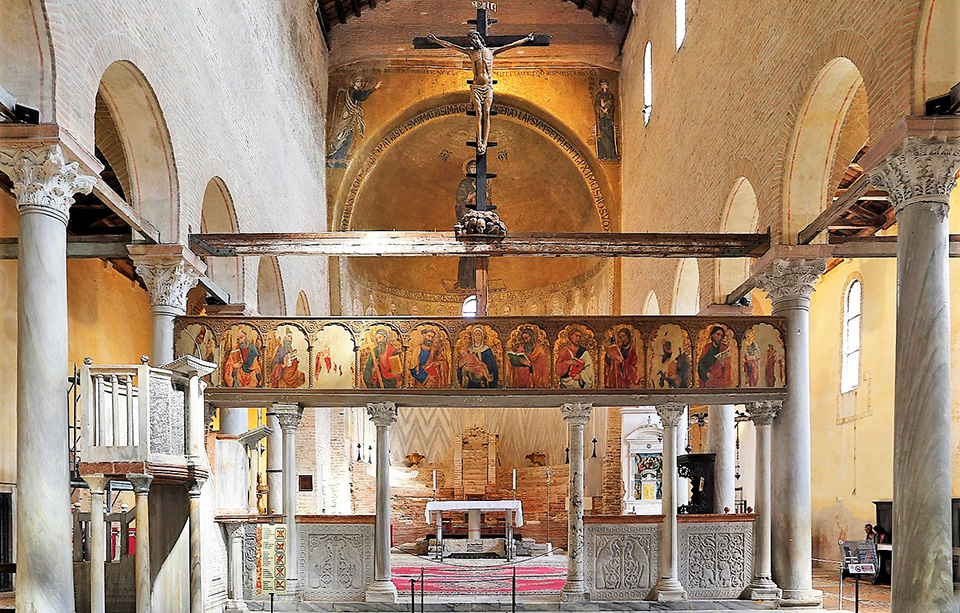The Torcello Island is a quiet and sparsely populated island at the northern end of the Venetian Lagoon. It is considered the oldest continuously populated region of Venice. Today it has 12 inhabitants.
Torcello is worth a visit: A magnificent Byzantine-Italian cathedral dating back to 639 A.D., the Basilica of Santa Maria Assunta, looms over the island with the Bell Tower and Church of Santa Fosca alongside. Allow 45 minutes or an hour to visit the religious buildings around the central piazza, which is a short walk along a canal from the Actv stop. Tickets are sold individually for the Basilica, the Bell Tower, and the small Archaeological Museum, but the best deal is a combination ticket that includes all three plus the use of an audioguide in the Basilica (still called the "Cathedral" by many, and still in use for weddings and religious festivals).
Sights of Torcello island
The former splendour of Torcello’s numerous palazzi, its twelve parishes and its sixteen cloisters has almost disappeared since the Venetians recycled the useful building material. The only remaining medieval buildings form an ensemble of four edifices.
Today's main attraction is the Cathedral of Santa Maria Assunta, founded in 639 and with much eleventh and 12th century Byzantine work, including mosaics (e.g. a vivid version of the Last Judgement), surviving. Other attractions include the eleventh and 12th century Church of Santa Fosca, which is surrounded by a porticus in form of a Greek cross, and a museum housed in two fourteenth century palaces, the Palazzo dell'Archivio and the Palazzo del Consiglio, which was once the seat of the communal government. Another noteworthy sight for tourists is an ancient stone chair, known as Attila’s Throne. It has, however, nothing to do with the king of the Huns, but it was most likely the podestà’s or the bishop’s chair.
Torcello is also home to a Devil's Bridge, known as the Ponte del Diavolo or alternatively the Pontecello del Diavolo (devil's little bridge).
Torcello History
After the downfall of the Roman Empire, Torcello was one of the first lagoon islands to be successively populated by those Veneti who fled the terra firma (mainland) to take shelter from the recurring barbarian invasions, especially after Attila the Hun had destroyed the city of Altinum and all of the surrounding settlements in 452. Although the hard-fought Veneto region formally belonged to the Byzantine Exarchate of Ravenna since the end of the Gothic War, it remained unsafe on account of frequent Germanic invasions and wars. During the following 200 years the Langobards and the Franks fuelled a permanent influx of sophisticated urban refugees to the island’s relative safety, including the Bishop of Altino himself. In 638 Torcello became the bishop’s official see for more than a thousand years and the people of Altinum brought with them the relics of Saint Heliodorus, now the patron saint of the island.
Torcello benefited from and maintaining close cultural and trading ties with Constantinople, after the fall of the western Roman Empire, but as a rather distant outpost of the Byzantine Empire it could establish de facto autonomy from the eastern capital.
Torcello rapidly grew in importance as a political and trading centre: In the 10th century it had a population of at least 10,000 people and was much more powerful than Venice. Thanks to the lagoon’s salt marshes, the salines became Torcello’s economic backbone and its harbour developed quickly into an important re-export market in the profitable east-west-trade, which was largely controlled by Byzantium during that period. Fortunately for the island of rivus altus (see Rialto), the lagoon around the island of Torcello gradually became a swamp from the 12th century onwards and Torcello’s heyday came to an end. Navigation in the laguna morta (dead lagoon) was impossible before long and the growing swamps seriously aggravated the malaria situation, so that the population abandoned the worthless island bit by bit and left for Murano, Burano or Venice. It now has a population of around 20 people.
Famous residents in Torcello
One of the most famous fans of the island’s decayed and contemplative charm was Ernest Hemingway who spent some time there in 1948, writing parts of Across the River and Into the Trees.
It is also prominently featured in Harold Pinter's play Betrayal, based on events in an affair he had in the 1960s with Joan Bakewell, the pivotal event of which occurred when she was vacationing in Venice.
